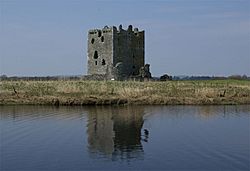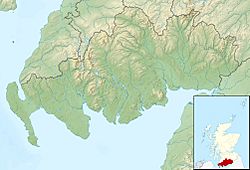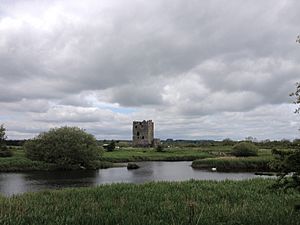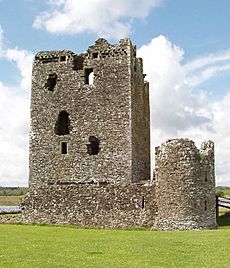Threave Castle facts for kids
Quick facts for kids Threave Castle |
|
|---|---|
| Near Castle Douglas, Dumfries and Galloway, Scotland | |

Threave Castle seen across the River Dee
|
|
| Coordinates | 54°56′21″N 3°58′11″W / 54.9392°N 3.9697°W |
| Type | Tower house |
| Height | 21 metres (69 ft) |
| Site information | |
| Owner | Historic Environment Scotland |
| Open to the public |
Yes |
| Condition | Ruined |
| Site history | |
| Built | c.1370 |
| Built by | Archibald the Grim, Lord of Galloway William Douglas, 8th Earl of Douglas |
| In use | c.1370–1640 |
| Battles/wars | Sieges in 1455 and 1640 |
Threave Castle stands on an island in the River Dee. It is about 2.5 kilometers west of Castle Douglas in Scotland. This historic castle was built around 1370.
The castle was a strong home for the powerful "Black Douglases" family. They were important lords in the area called Galloway. Their power lasted until 1455. For some time, Princess Margaret, the daughter of King Robert III, lived here. She was the wife of the 4th Earl of Douglas.
In 1449, the 8th Earl of Douglas took control of Threave. He was a very powerful leader in Scotland. He made the castle even stronger by adding an "artillery house." This was a new type of defense for its time, designed to use cannons. However, the Douglas family became too powerful. King James II decided to stop them in 1455. His army attacked and captured Threave Castle.
After this, Threave became a royal castle, meaning it belonged to the King. In the 1500s, the Maxwell family became responsible for the castle. It was briefly held by the English in the 1540s. The castle saw more fighting in 1640 during the Bishops' Wars. A group of King Charles I's soldiers held the castle. They were attacked by the Covenanters, who were against the King.
After being partly taken apart, the castle was not used much. In 1913, it was given to the state to be looked after. Today, the ruins of the tower house and the artillery house are cared for by Historic Environment Scotland. It is a special historic site. You can visit the castle by taking a boat across the River Dee.
Contents
Castle History
The name Threave probably comes from an old language word meaning "homestead." This suggests people lived on the island long before the castle was built. Some stories connect the island to Fergus of Galloway, a leader from the 1100s. But there is no real proof of this.
Records show that in 1308, Edward Bruce fought a battle on the River Dee. He then "burnt up the island." Old coins found at Threave suggest this event might have happened here. Digs in the 1970s found signs of older buildings. These might have been part of an early fort for the Lords of Galloway.
The Powerful Douglas Family
The Douglas family was very loyal to Robert the Bruce during Scotland's fight for independence. They helped defeat English supporters in Galloway. Because of their help, the Douglas family was given many rewards. Sir William Douglas became the Earl of Douglas in 1358. His cousin, Archibald Douglas, became the Lord of Galloway in 1369.
Archibald was known as "Archibald the Grim" because he was a tough fighter. He spent years attacking the English near the border. By 1372, he controlled all of Galloway. To protect his new lands, Archibald needed a strong castle. It is believed that Threave Castle was built around this time. The main tower, called the keep, was one of the first of its kind in Scotland. It stood alone without other defenses at first. A small harbor was built for boats to reach the castle. Later digs showed more stone buildings from the late 1300s, possibly a hall and a chapel.
In 1384, Archibald captured Lochmaben Castle, the last English fort in southwest Scotland. In 1388, he became the 3rd Earl of Douglas. This made him the most powerful noble in Scotland. He owned lands and castles all over southern Scotland. He helped rebuild Sweetheart Abbey and arranged marriages for his children with the King's children. He probably did not spend much time at Threave. However, he died there in 1400, which is the first time the castle is mentioned in history.
His son, Archibald, became the 4th Earl. In 1390, he married Princess Margaret, King Robert III's daughter. He was killed fighting in France in 1424. His wife, Princess Margaret, then ruled Galloway from Threave for 23 years. She was a Countess and Duchess. In 1449, she had to give Galloway to the 8th Earl of Douglas. She died at Threave soon after. Her tomb is at Lincluden Collegiate Church. A special metal seal made for Margaret was found at Threave. It shows her family's coat of arms mixed with the King's.
The Douglas Family Loses Power
The Douglas family's power kept growing. Archibald, the 5th Earl, became a leader for the young King James II in 1437. But he died unexpectedly in 1439. After his death, other powerful nobles wanted to take over the Douglas family's power. In 1440, they tricked Archibald's sons, William and David, into coming to Edinburgh Castle. At a sad event called the "Black Dinner," the two boys were unfairly killed. This happened even though the ten-year-old King James II protested. James Douglas, Archibald the Grim's son, gained the most from this. He became the Earl of Douglas.
When James died in 1443, his oldest son, William, became the 8th Earl of Douglas. The next year, he married his cousin, Margaret, known as the "Fair Maid of Galloway." This marriage brought all the Douglas lands back together. Other nobles were worried about the Earl's power and his influence over the young King James II. In 1447, Earl William forced the elderly Princess Margaret to leave Threave Castle. This finally gave him full control of Galloway.
He started to make Threave's defenses much stronger. He tore down older buildings and built new outer defenses. These included a wall along the river and the "artillery house." This new wall had three towers designed to hold cannons. It was one of the first forts in Britain built specifically for artillery.
In 1452, the Earl captured Patrick Maclellan, the Sheriff of Galloway. He held him prisoner at Threave. Even though the King asked for his release, Maclellan was killed. On February 22, 1452, Douglas was called to Stirling Castle. The King had promised him safety. The King wanted Douglas's help against other rebellious Earls. But Douglas had made a deal with these Earls and refused to help the King. The King then stabbed Douglas. The King's guards then attacked and killed Douglas. His body was thrown from a window.
The Siege of Threave
William's brother, James Douglas, became the 9th Earl. He quickly finished the defenses at Threave. He completed the artillery house and built earth walls to the north. After his brother's death, he secretly worked with the English King. He even received money from England for the castle's defenses. But the 9th Earl's rebellion was defeated in a battle in 1455. After this, the King's army attacked the Douglas castles one by one.
Threave Castle was the last one to fall. The King's forces arrived in June. King James stayed nearby during the attack, which lasted over two months. The new artillery house made it hard for the King's men to capture the castle by force. They even brought a huge cannon, called a bombard, from Linlithgow Palace. But even with this, they could not break through. Instead, King James convinced the soldiers inside to give up. He offered them money and land.
There is a story that the famous cannon Mons Meg was built in Kirkcudbright. The story says it was used at Threave. It supposedly shot a cannonball right through the castle, hitting the Fair Maid's hand. However, we know that Mons Meg was actually made in France. It did not arrive in Scotland until 1454, after the siege of Threave.
A Royal Fortress
After the siege, the castle and the lands of Galloway became part of the Crown. The King appointed new keepers to look after it. King James II returned in 1460 on his way to another castle siege. He was killed there by an exploding cannon. James III gave the castle to his wife, Margaret of Denmark. But we do not know if she ever visited. King James IV visited in 1502. Records show that cloth, wine, and falconers were brought to Threave for him.
In 1513, Robert Maxwell was made keeper of the castle. In 1526, this job became permanent for the Maxwell family. In 1542, Robert Maxwell was captured by English invaders. He was forced to give Threave to them. But it was taken back for Scotland in 1545. The Maxwell family was Catholic, and Scotland was becoming Protestant. They were often suspected of being disloyal. Lord Maxwell had to give up Threave temporarily when the Spanish Armada was near England.
During the Bishops' Wars (1638-1640), the Maxwells supported King Charles I. About 100 soldiers were placed at Threave. More earth defenses were added. The army of the Covenanters, who were against the King, arrived in the summer of 1640. They attacked the castle. After holding out for 13 weeks, the soldiers gave up. King Charles himself ordered them to surrender. The Covenanters then ordered the castle buildings to be taken apart.
Later History
The main tower and artillery house mostly remained standing. But Threave was never lived in again. Around 1800, during the Napoleonic Wars, some changes were made. This was to hold French prisoners, but it is not clear if it was ever used for this. In 1913, the ruins were given to the state to be cared for. Some repairs and digs were done. The castle has been a special historic site since 1921. More detailed digs in the 1970s showed more about the castle's past. Threave Castle is looked after by Historic Environment Scotland. It is open to the public. You can reach the castle by boat from the Threave Estate. This estate is a nature reserve with bats and ospreys.
Castle Features
Threave Castle has a tower house from the 1300s. It also has an outer wall with an artillery house from the 1400s. The castle is on the western side of the island. Today, the island is about 8 hectares. But in the 1400s, it was only about a third of that size. The island would have had other buildings, like storage areas and workshops. You could get to the castle by boat or by walking across a shallow part of the river.
The Keep
The main tower, called the keep, is a rectangle. It is about 18.4 meters long and 12.1 meters wide. It stands 21 meters high. Inside, there were five floors. The only way into the keep was through an entrance on the east side. You reached this by a wooden staircase and a movable bridge. This entrance was on the second floor. It led into a reception hall. Also on this floor was the kitchen. Below this were storage rooms with a well and a prison. You reached these by a ladder.
From the reception hall, a spiral staircase inside the 2-meter-thick wall led up to the great hall. Above this were the lord's outer room and bedroom. These rooms had larger windows on the west and north sides, which were safer.
The top floor was for servants or soldiers during attacks. You could get to the top walls from this floor. Nine windows gave views in all directions. An outer door on this level allowed heavy things to be pulled up from the ground. On three sides, holes in the outside walls held a wooden walkway. This allowed defenders to drop things on attackers below. A stronger stone structure over the entrance did the same job.
Outer Walls and Other Parts
The keep is surrounded by a later outer wall. This wall goes around the east, south, and west sides of the keep. The east and south parts form the "artillery house." The 8th Earl of Douglas started building this in 1447. It was a very advanced defense for its time. It faced the higher ground to the east of the river, where an attack was most likely.
The artillery house has round towers at its three corners. These towers have three gun openings on two levels. The top level has a wall with gaps for defenders. The lower gun openings are shaped like 'dumb-bells.' The ones above are shaped like 'inverted keyholes.' Guns placed in these openings would have been small cannons. Only one of these towers, the southeast one, is still standing. The others were damaged in the 1640 siege and fell down.
Between the towers is a curtain wall. It is 1.5 meters thick and used to be up to 6 meters high. It slopes outwards at the bottom to make it stronger against cannon fire. It also has narrow slits for firing longbows or crossbows. In the middle of the east wall is a gatehouse, almost 8 meters high. It used to have a drawbridge and two inner doors. There was a platform above for firing weapons. You would have reached the curtain walls by ladders or wooden stairs. The curtain walls are only 4.4 meters from the keep. It is not clear if there was a direct way to get from one to the other. A ditch dug into the rock surrounds the curtain wall. This ditch used to be filled with water to form a moat.
To the west, the river runs close to the keep. Parts of a wall remain along the river bank. It curves back towards the northwest corner of the keep. A gated harbor was built here. This provided a safe way to get into the castle by boat. To the north, only an earth bank protects the keep. But the marshy ground on this side would have made it hard for attackers. Beyond the artillery house and its ditch, you can see the foundations of older buildings. These were taken down to get stone and to clear the area for the artillery house's guns. The very outer defense is an earth wall. Lord Maxwell's soldiers quickly built this before the 1640 siege.






